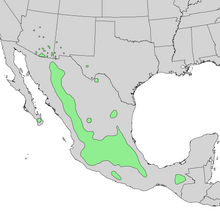| Quercus rugosa | |
|---|---|

| |
|
Scientific classification
| |
| Kingdom: | Plantae |
| Clade: | Tracheophytes |
| Clade: | Angiosperms |
| Clade: | Eudicots |
| Clade: | Rosids |
| Order: | Fagales |
| Family: | Fagaceae |
| Genus: | Quercus |
| Subgenus: | Quercus subg. Quercus |
| Section: | Quercus sect. Quercus |
| Species: | Q. rugosa
|
| Binomial name | |
| Quercus rugosa | |

| |
| Natural range of Quercus rugosa | |
| Synonyms [2] | |
|
List
| |
Quercus rugosa, commonly known as the netleaf oak, is a broad-leaved tree in the beech and oak family Fagaceae. It is native to southern North America.
Description
Quercus rugosa is an evergreen shrub or tree. [3] The bark is brown and scaly. The leaves are thick and leathery, rarely flat, usually cupped, up to 15 centimetres (6 inches) long, dark green on the top but covered with a thick of reddish-brown hairs on the underside. [4] [5] The young leaves are also very hairy and usually red or yellow.

Name
Quercus rugosa is Latin for "wrinkled oak". In Spanish it has many common names, like "encino negro" (black oak) or "encino quiebra hacha" (axe-breaking oak). Colloquially it is known as "chaparro", a word which has also passed into the lexicon as slang for a short person.
Distribution
It is widespread in Mexico, Guatemala and the southwestern United States ( Arizona, New Mexico, western Texas). [6] [7] [8] [9] [10] It grows extensively in the temperate highlands of central Mexico, particularly on hillsides and in narrow gorges, between 1,800 and 2,900 meters elevation. [1] It is associated and usually coexists with other oaks, alders, pines and Texas madrones.
See also
References
- ^ a b Jerome, D. 2017. Quercus rugosa. The IUCN Red List of Threatened Species 2017: e.T194227A2305094. https://dx.doi.org/10.2305/IUCN.UK.2017-2.RLTS.T194227A2305094.en. Accessed on 18 October 2022.
- ^ Quercus rugosa Née. The World Flora Online. Accessed 17 October 2022.
- ^ CONABIO, Quercus rugosa
- ^ Nixon, Kevin C. (1997). "Quercus rugosa". In Flora of North America Editorial Committee (ed.). Flora of North America North of Mexico (FNA). Vol. 3. New York and Oxford: Oxford University Press – via eFloras.org, Missouri Botanical Garden, St. Louis, MO & Harvard University Herbaria, Cambridge, MA.
- ^ Née, Luis. 1801. Anales de Ciencias Naturales 3(9): 275 short diagnosis in Latin, description and commentary in Spanish
- ^ USDA, NRCS (n.d.). "Quercus rugosa". The PLANTS Database (plants.usda.gov). Greensboro, North Carolina: National Plant Data Team. Retrieved 2008-05-17.
- ^ "Quercus rugosa". County-level distribution map from the North American Plant Atlas (NAPA). Biota of North America Program (BONAP). 2014.
- ^ SEINet, Southwestern Biodiversity, arizona chapter
- ^ McVaugh, Rogers. 1974. Flora Novo-Galiciana: Fagaceae. Contributions from the University of Michigan Herbarium 12(1,3): 1–93.
- ^ Romero Rangel, S., E. C. Rojas Zenteno & M. L. Aguilar Enríquez. 2002. El género Quercus (Fagaceae) en el estado de México. Annals of the Missouri Botanical Garden 89(4): 551–593
